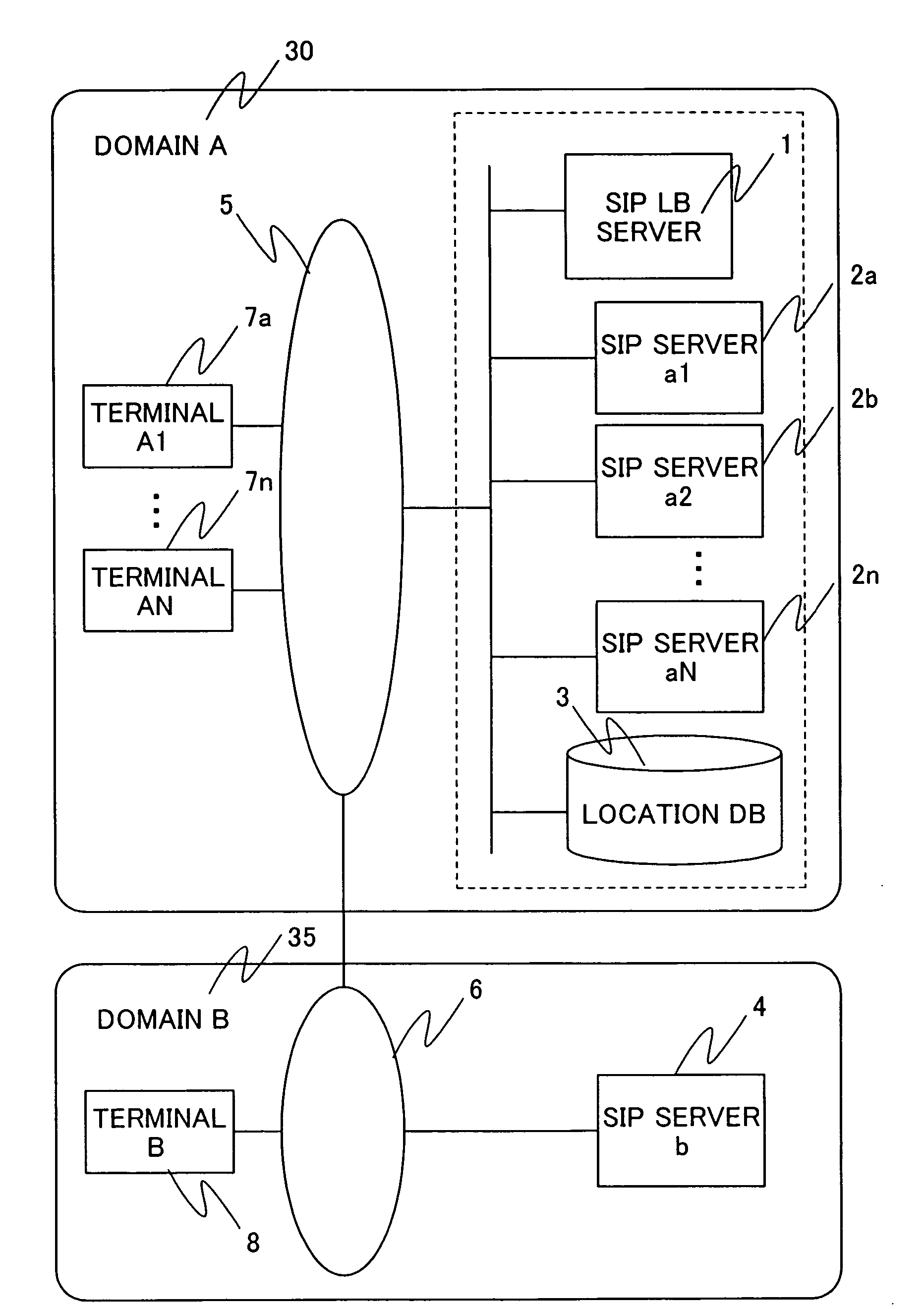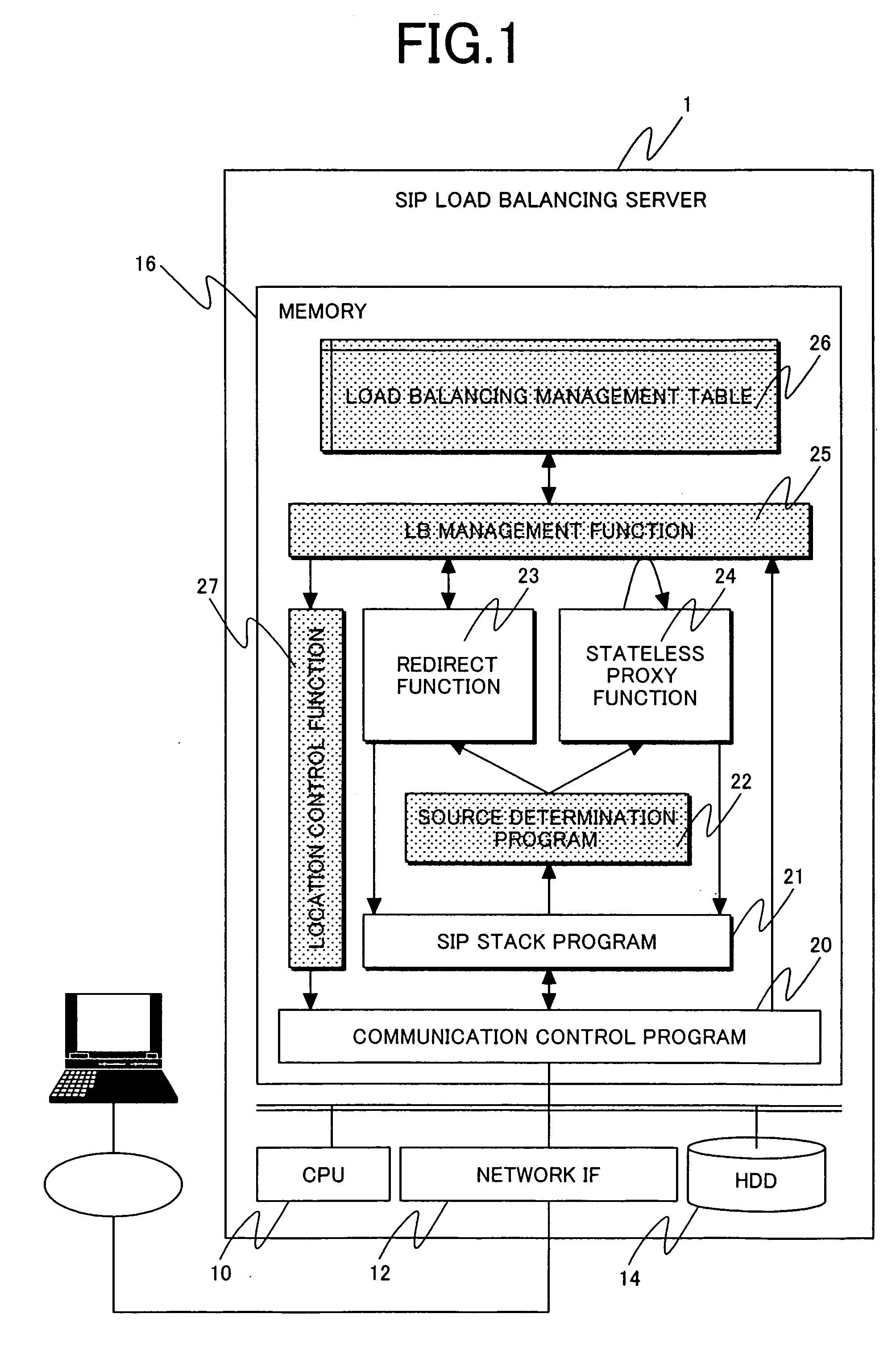Load balancing server and system
a load balancing server and load balancing technology, applied in the field of load balancing servers and systems, can solve the problems of inability to handle requests from servers or the like, and achieve the effect of preventing the consumption of resources of multiple servers assigned for serving a single terminal and effective server resources
- Summary
- Abstract
- Description
- Claims
- Application Information
AI Technical Summary
Benefits of technology
Problems solved by technology
Method used
Image
Examples
first embodiment
[0037]FIG. 1 shows an example of a SIP load balancing server architecture for a first embodiment of the invention. Although SIP is taken as an example in the first embodiment, the invention may be applied to other application layer protocols (other session control protocols). The SIP load balancing server 1 includes a CPU (10), a memory (16), and a storage device (14) and a suite of programs for control which will be detailed below is stored. When the SIP load balancing server operates, the control program suite is loaded into a memory space provided in the mainframe and executed by the CPU. The storage device may be installed in the mainframe, may be installed as an external storage device in another frame, or may be connected to the server via a network.
[0038] The load balancing server shown in FIG. 1 may include a user interface for allowing a user authorized to manage the server to operate the load balancing server. The user interface preferably includes, for example, a keyboar...
second embodiment
[0070] In a SIP load balancing system for a second embodiment, FIG. 11 shows an example of a method for handling a request message addressed to a terminal 7 in the local domain, routed via a SIP server 4 in another domain.
[0071] A request message which is transmitted from a terminal 8 belonging to another domain (domain B) 35, addressed to the terminal 7 belonging to the local domain (domain A) is first transmitted to the SIP server b 4 to which the terminal 8 belongs (F100). The SIP server b4 forwards the received request message to a SIP server in the domain to which the destination terminal 7 belongs. In the operation of the SIP load balancing system for the second embodiment, the SIP LB server 1 is assigned a SIP server representative address (e.g., domain A.co.jp) for managing the domain A. Thus, the request message which is forwarded via the SIP server b4 is sent to the SIP LB server 1 (F101).
[0072] On the SIP LB server 1 that received the request message sent from the SIP s...
third embodiment
[0083]FIG. 13 shows an example of a method of communication between terminals in one domain in a SIP load balancing system for a third embodiment. A terminal a1 (7a) and a terminal aN (7n) have set up continuous connections (sessions), respectively, with a SIP server a1 (2a) and a SIP server aN (2n) notified from the SIP LB server 1 in the same procedure as described for FIG. 3. In this state, how a request message from the terminal a1 is routed to the terminal aN is described.
[0084] The request message issued by the terminal a1 is first sent to the SIP server a1 having an established session with the terminal a1 (F130). By referring to the destination of the message, the SIP server a1 knows that the destination is a terminal belonging to the same domain. Now, if the server maintains location information for the terminals that it serves in a cache on a memory or a local hard disk, it checks whether the destination terminal's information is found in the location information in the c...
PUM
 Login to View More
Login to View More Abstract
Description
Claims
Application Information
 Login to View More
Login to View More - R&D
- Intellectual Property
- Life Sciences
- Materials
- Tech Scout
- Unparalleled Data Quality
- Higher Quality Content
- 60% Fewer Hallucinations
Browse by: Latest US Patents, China's latest patents, Technical Efficacy Thesaurus, Application Domain, Technology Topic, Popular Technical Reports.
© 2025 PatSnap. All rights reserved.Legal|Privacy policy|Modern Slavery Act Transparency Statement|Sitemap|About US| Contact US: help@patsnap.com



